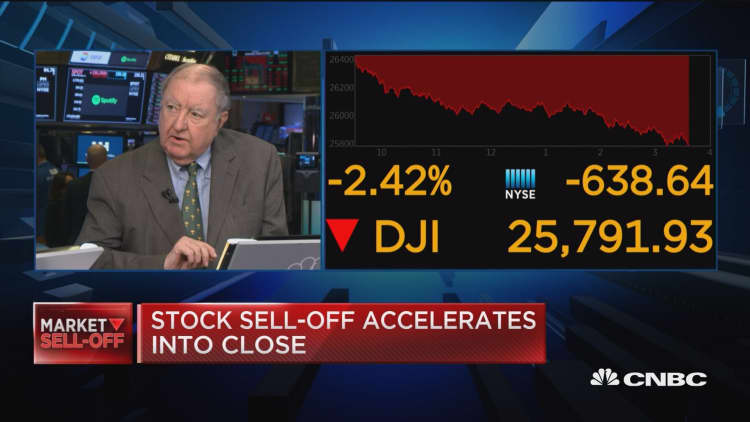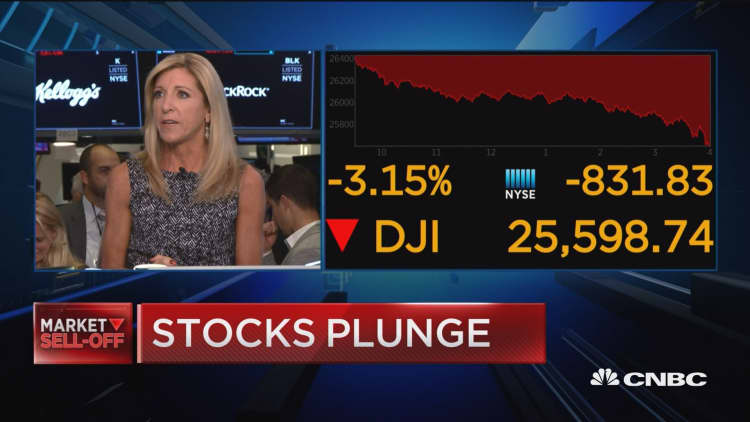Wednesday's vicious stock sell-off may have been painful to watch, but it ultimately could be just what the market needed.
Investors watching what ended up as an 832-point loss in the Dow Jones Industrial Average couldn't help but remember the frenzied correction that began in late January and never really abated until April. Multiple trading days looked a lot like Wednesday's action, with the blue chip dropping hundreds of points in a matter of minutes.
But that's where the comparison ends, said Jamie Cox, managing partner at Harris Financial Group.
"This was way different than February and March," Cox said of the sell-off that began over inflation fears, much the same as the current market condition. "In February, everything got shellacked. Even banks didn't get hit that bad today. It wasn't what you'd expect in a full-blown washout sell-out. To me, that was the most important piece, that this is not going to herald something worse."

There's some truth to that when looking at how individual market components fared.
Tech, by far, took the worst of the beating, with the sector off 4.8 percent on the day. Its recently spun-off sibling, communication services, was next, with a drop just short of 4 percent. Apple shaved 67.5 points off the Dow, the second-biggest impact on the blue chip index. On the other end of the scale, defensive sectors still lost but not nearly as much, as utilities fell 0.5 percent and staples were off just 1.3 percent.
For some market watchers, the idea of a little consolidation in tech could be a positive.
"A lot of the high flyers are the ones that have gotten beat up," said Joe Saluzzi, a principal at Themis Trading. "The FAANG stocks, the Amazons of the world, they are up ridiculous. Those are momentum-type trades. A little air coming out is a healthy thing as long as fundamentals haven't changed. I don't have a problem with that type of sell-off."
Saluzzi added that what the market has experienced this year doesn't resemble worse days, like during the financial crisis.
"That was pure gut-wrenching fear, and deservedly so, because we were on the brink," he said. "Now it has a much different feel. This is like an air-letting right now."

Market experts cited a slew of factors that are contributing to the downdrift: fear the Fed will raise interest rates aggressively, worry from tech companies that tariffs on Chinese imports will drive costs higher, and even the upcoming earnings season as expectations fall for corporate profits.
Combine that with programmed trading, and it gives rise to some of the panic selling the market went through Wednesday.
"People are taking cover," said Quincy Krosby, chief market strategist at Prudential Financial. "One of the things that helpful is when you're pretty negative going into earnings season, then positive surprises do help. The shorts have to cover."
Another earnings factor that could be positive is share buybacks. Krosby said companies have announced aggressive plans for repurchases but haven't executed them fully. Lower prices would encourage more buybacks.
Back in February, the backdrop of sound fundamentals along with companies' willingness to support their own shares helped the market recover and pave the way to a healthy bounceback that saw major indexes recently eclipse all-time records.
At least for now, there's optimism that this drop also will be met with more buying, so that would be the one way the two periods resemble each other.
"I don't think [the past week's sell-off] is something more fundamental," said Brad McMillan, chief investment officer for Commonwealth Financial Group. "A good example is at the end of January and the beginning of February, we saw the market get ahead of itself, and we saw the air come out. Once we saw the market consolidate, then we saw an upward move."


